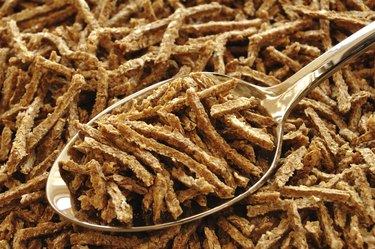
Consuming more bran or whole grains can help lower your risk for heart disease, according to a study published in "Circulation" in 2010. You can add bran to baked goods in place of up to one-fourth of the flour, sprinkle it on yogurt or in smoothies or cook it with water or milk to make a hot cereal. Wheat bran and oat bran offer different health and nutrition benefits, so you may want to include both in your diet.
Calories and Major Nutrients
Video of the Day
A 1-cup serving of oat bran, which is about 94 grams, provides 231 calories, 6.6 grams of fat, 16.3 grams of protein and 62.2 grams of carbohydrates. Each cup of wheat bran, which only weighs 58 grams, contains 125 calories, 2.5 grams of fat, 9 grams of protein and 37.4 grams of carbohydrates. You can eat twice as much wheat bran while still consuming fewer calories and less fat than if you opted for oat bran.
Video of the Day
Fiber Type and Content
Wheat bran also provides more fiber, with 24.8 grams per cup, than oat bran, which only contains 14.5 grams per cup. However, the type of fiber in these two types of bran is different. Wheat bran consists of more than 90 percent insoluble fiber, while only between 50 and 60 percent of the fiber in oat bran is insoluble. Soluble fiber, like that in oat bran, absorbs water and forms a gel in the digestive tract, while insoluble fiber adds bulk without absorbing water.
Major Minerals
Both of these types of bran contain high amounts of all the essential minerals except calcium. Although oat bran is higher in phosphorus, providing 69 percent of the daily value compared with the 59 percent of the DV in wheat bran, wheat bran is higher in potassium, zinc, iron, selenium, manganese, copper and magnesium. Both oat and wheat bran are sodium-free foods. Potassium helps with blood pressure control, zinc and copper help keep your immune system healthy and selenium acts as an antioxidant. You need phosphorus and magnesium for forming DNA and strong bones and manganese for processing cholesterol.
Vitamin Content
Which type of bran is more vitamin-rich is a bit of a toss-up, with wheat bran providing more niacin, riboflavin and vitamin B-6 and oat bran containing more thiamine, pantothenic acid and folate. Neither is a particularly good source of vitamins A, B-12, C, E or K. You need the B vitamins provided by oat and wheat bran for turning the food you eat into energy and keeping your nervous system and liver functioning properly.
Potential Health Benefits
Wheat bran is particularly helpful for digestive issues, because the insoluble fiber can help bulk up your stools and limit your risk for constipation and other digestive issues. Oat bran, with it's high soluble fiber content, may help you better control your blood sugar levels. A study published in the "European Journal of Clinical Nutrition" in September 2011 found that consuming 6 grams of soluble fiber per day from oat bran may help you lower your cholesterol and triglyceride levels and also limit the amount of energy you absorb from your food, potentially making it easier to maintain a healthy weight.
- Circulation: Whole-Grain, Cereal Fiber, Bran, and Germ Intake and the Risks of All-Cause and Cardiovascular Disease–Specific Mortality Among Women With Type 2 Diabetes Mellitus
- HealthALiciousNess.com: Nutrition Facts Comparison Tool
- American Journal of Clinical Nutrition: Mechanisms By Which Wheat Bran and Oat Bran Increase Stool Weight in Humans
- European Journal of Nutrition: Oat: Unique Among the Cereals
- European Journal of Clinical Nutrition: A Diet Rich in Oat Bran Improves Blood Lipids and Hemostatic Factors, and Reduces Apparent Energy Digestibility in Young Healthy Volunteers
- Dietary Fibre: New Frontiers for Food and Health: The Effect of Wheat Bran on Various Measures of Bowel Function and Regularity